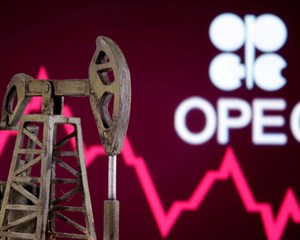Iran is a more likely source of new supply. The country's negotiators are trying to strike a deal with America that would lift economic sanctions in return for limits on its nuclear ambitions. If they succeed, Iran could add around 1m barrels a day to the market by the end of the year; it could also sell the 200m barrels it currently has in storage. Chris Midgley of s&p Global Platts, a data firm, points out that Saudi officials do not want a replay of 2018, when America's decision not to reimpose oil sanctions on Iran took them by surprise and sent oil prices lurching downwards.
伊朗是一个更有可能的新供应来源。该国的谈判代表正试图与美国达成一项协议以解除对其核野心的经济制裁作为交换条件。如果他们成功了,到今年年底伊朗可以每天向市场增加100万桶原油。它还可以出售目前储存的2亿桶石油。标准普尔全球普氏能源信息公司的克里斯·米德格利指出,沙特官员不想重蹈2018年的覆辙,当时美国决定不重新对伊朗实施石油制裁令他们感到意外并导致油价暴跌。
What, then, to expect from the cartel and its allies? There are three scenarios. One is that countries start producing whatever they want, a price war ensues, and oil prices tumble. Analysts reckon that this is the least likely outcome. Energy ministers still bear the scars of the ill-timed price war of March 2020, when Russia and Saudi Arabia failed to agree on production cuts. The market was flooded with oil just before demand suffered its covid-induced collapse.
那么,我们能从卡特尔及其盟友那里期待什么呢?有三种情况。一是各国开始生产他们想要的东西,随之而来的是价格战,油价暴跌。分析人士认为这是最不可能的结果。2020年3月,俄罗斯和沙特阿拉伯未能就减产达成一致,当时不合时机的价格战给能源部长们留下了伤疤。就在新冠肺炎导致需求崩溃之前,市场上石油量充足。

Another possibility is that a new deal fails to be struck, and that countries stick to their current quotas. That would mean the extra post-July production increases that the market had been expecting do not materialise. Coupled with a summer uptick in demand from holidaymakers as they fly or drive to their destinations, that would push prices up, perhaps over $80 a barrel. The most likely outcome from the row, however, is a compromise. One possibility is that the UAE and some other countries are allowed a temporary increase in output and the thorny issue of quota revision is kicked down the road.
另一种可能性是,新协议无法达成,各国将坚持现有配额。这将意味着市场此前预期的7月后额外的产量增长不会出现。再加上夏季度假者乘飞机或开车前往目的地时需求的上升,这将推高油价至可能超过每桶80美元。然而,争吵最可能的结果是妥协。一种可能性是,阿联酋和其他一些国家被允许暂时增加产量,而配额修订的棘手问题将被搁置。
Even if a deal is struck, however, the spat may portend further disagreements— and more price volatility. OPEC+ members are using divergent strategies when it comes to the energy transition and the oil markets, argues Francesco Martoccia of Citigroup, a bank. Faced with dwindling demand in the long term, some producers, such as the UAE, want to boost supply and monetise petroleum reserves earlier. Others, such as Saudi Arabia, want to restrict production to keep prices high. Such divisions will become even clearer as the shift towards a greener economy accelerates. OPEC's latest tiff won't be its last.
然而,即使达成了协议,争执也可能预示着进一步的分歧——以及更大的价格波动。花旗银行的Francesco Martoccia认为,当涉及到能源转型和石油市场时,欧佩克+成员国正在使用不同的策略。面对长期的需求下降,阿联酋等一些产油国希望增加供应,尽早将石油储备货币化。其他国家,如沙特阿拉伯,则希望限制产量以保持高油价。随着向绿色经济的转变加速,这种分歧将变得更加清晰。欧佩克最近的争执不会是最后一次。
译文由可可原创,仅供学习交流使用,未经许可请勿转载。











